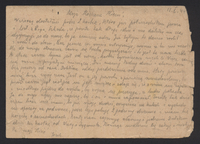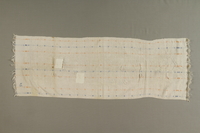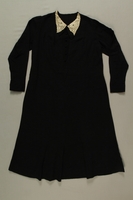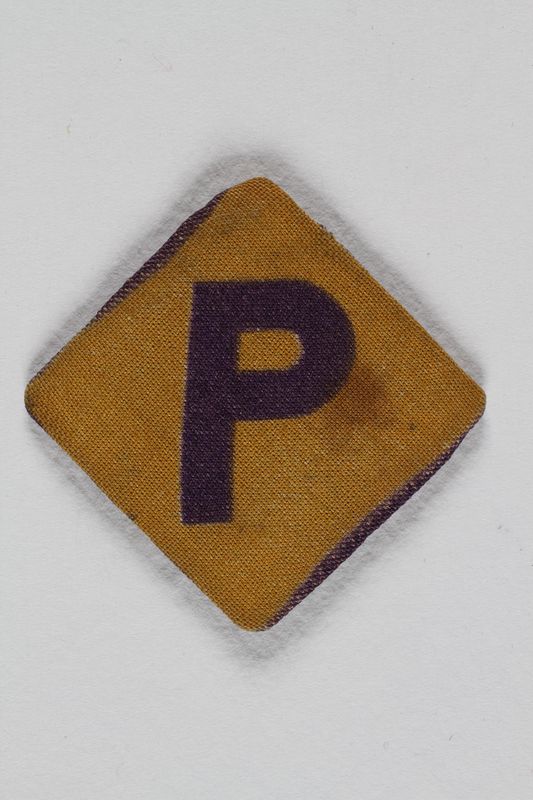Overview
- Brief Narrative
- Yellow badge with a purple P worn by 21 year old Krystyna (Kay) Nabel, to identify her as a Polish forced laborer in Germany from 1943-1944. During the German occupation of Poland, many non-Jewish Polish people were sent to Germany as conscript labor. When Kay and her husband Edward, Polish Jews, wore these badges they were living under false identities as Polish Catholics. Soon after Germany invaded Poland in September 1939, Kay Selinger left her family in Krakow and fled with her future husband, Edward Nabel, to Lvov (Lviv, Ukraine] where his parents had already relocated. They married there in June 1940. After Germany invaded the Soviet Union in June 1941, they returned to Krakow to escape the anti-Jewish pogroms launched by the Germans and the local Ukrainian population. When the Krakow ghetto was being liquidated by the Germans, Kay and Edward were sent to Bauhof labor camp. They escaped and, around November 1942, assumed false identities as Polish Catholics. They were sent as forced labor to Germany. Under their false identities, they were not married, so although for a time they worked on the same farm, most of this time they were assigned to separate locations. When they learned that Allied forces were approaching, they escaped and hid in the forests near Kongishofen where they were liberated by American troops on April 8, 1945. Edward's parents and all of Kay's family were killed in concentration camps. In October 1949, Kay and Edward emigrated to the US.
- Date
-
use:
1943-1944
- Geography
-
use:
Germany
- Credit Line
- United States Holocaust Memorial Museum Collection, Gift of Kay Nabel
- Markings
- front, purple ink : P
- Contributor
-
Subject:
Kay Nabel
- Biography
-
Kay (Krystyna) Selinger (later Nabel) was born on October 20, 1922, in Krakow, Poland, to Wilhelm and Henryka Lewinger Selinger. She had a sister, Maryla, born in 1914 in Vienna, Austria, and a brother, Jan, born in 1916. Her father had a store where he repaired and sold machinery that he imported from Germany. Kay was very close to her maternal grandmother, Leontyna Lewinger. The family spent summers with her in Alwernia, 20 miles outside Krakow, and she stayed with the family during the winter. Although her father attended services weekly, the family was not particularly observant, except for the Jewish holidays. They spoke Polish at home. Kay attended an all girl’s school with a mixture of Jewish and non-Jewish students. The family lived comfortably until 1933, but after that her father’s business struggled because of the Depression.
On September 1, 1939, the Germans invaded Poland. Kay’s father and sister fled east, but soon returned because of Wilhelm’s poor health. Some minor preparation for gas attacks had been made, but the bombs were a shock. Many people built ditches for cover, but Kay’s family hid in their basement. Krakow was occupied within a week. Her brother had joined the Polish army two years previously, but after the German occupation, the family lost contact with him.
The Germans quickly implemented measures to exploit and persecute the Jewish population. Kay and Edward Nabel, born 1912, who had been her boyfriend since 1938, along with Edward’s brother, Jozek, and his girlfriend, decided to flee Krakow. Edward’s parents, Gustav and Rose Nabel, had already escaped to Lvov (Lviv, Ukraine), in the Soviet controlled sector in eastern Poland. They owned a silverware factory and the family wished to preserve their production pattern molds. Using kayaks to carry the molds, Kay and the others traveled to Lvov on the Vistula River. After 2-3 days, they buried the molds and continued on foot to Lvov, about 125 miles through German occupied territory. Once they arrived, Kay, as a single woman with no means of support, was targeted by the Soviets for deportation to Siberia. For several weeks, she avoided deportation by living in another town with Edward’s cousins, Mania and Lolek Singer. Eventually, on June 5, 1940, she and Edward married, first with a rabbi who predated their papers, and a second time as a civil marriage. She had not met his parents before this point, but soon all three couples were living together in one room.
In the spring of 1941, the Germans launched a surprise invasion of the Soviet Union. The Germans occupied Lvov and encouraged the local Ukrainian population in repeated violent pogroms that massacred thousands of Jews and destroyed Jewish occupied areas of the city. It was illegal for Jews to travel, but Edward’s parents escaped toward Krakow and Kay and Edward soon followed. The Germans had established a Jewish ghetto in Krakow and before they could enter, Kay and Edward had to marry again in a German service because they had to conceal their time in Lvov.
Kay’s parents had been imprisoned in the Jewish ghetto in Krakow since September 1940. They had to report every day for work assignments, such as digging ditches and cleaning for the Germans. There were frequent beatings and they were constantly afraid for their lives. In 1942, the Germans decided to empty the ghetto. Everyone was told to report for work duty, and the Germans separated them into groups by age and health. Kay and Edward were sent home the day the family reported, but Kay’s parents, her sister, and her husband were deported to Treblinka concentration camp. Edward’s parents were put on a transport a few days later. Kay’s grandmother, bedridden in a home for the elderly, was shot in her bed.
Edward and Kay were selected for the Bauhof labor camp near Krakow, where Edward worked in the machine shop and Kay crushed stones for roadwork. In September 1942, a prisoner was caught trying to escape. Seeing trucks arriving to transport the prisoners to concentration camps, Edward and Kay decided to escape through a weak link in the fence. Other prisoners followed and the guards began shooting them. Several bodies fell on top of the couple and Edward and Kay remained under the pile of corpses until after dark when they crept out to wash themselves in the river. They decided to go to the house of a non-Jewish Pole who worked at the camp and he hid them in a shack in his yard. They next made their way to a former neighbor’s house, Zofia Klebek, and she gave them money and clothes. Then they contacted a friend of Edward’s, Alfred Zbik, whose parents were involved in the Polish underground. They gave them refuge in their home for two months. Alfred was a Polish civil servant and managed to acquire false papers for them from the Polish Home Army office: Edward became Jozef Mucha and Kay became Helena Kudlnia. He obtained a medical certificate for Edward stating that he had not been circumcised, so that he could avoid a physical exam. Now registered as Catholic Polish persons, they were sent as forced labor to Germany. Initially they worked on separate farms, as under their false identities, they were both unmarried, but they eventually worked on the same farm in Kleinbardof. At some point, Edward was sent to dig ditches on the Siegfried Line, a large German border fortification. To avoid working for the defense of Germany, Edward followed advice from Australian POWs to eat a specific plant that caused swelling in his feet. During this time, Edward wrote many letters to Kay who was now doing housework for a pro-Nazi family.
In April 1945, aware that allied forces were advancing nearby, Edward, Kay, and another Jewish friend living under a false identity, hid in the forest surrounding Königshofen. After three days, they returned to find that the city had been liberated by the United States Army on April 8. The couple relocated to Bad Neustadt, where they were one of only two Jewish families. American soldiers restored the town’s synagogue, and a rededication service was held with the Jewish soldiers and chaplain. Kay attempted to locate her brother, but the Red Cross was only able to inform her that his last known location was a prison camp in the Soviet Union. Kay opened a textile shop, and Edward worked as a lawyer. The couple immigrated to New York in October 1949, where Kay had a maternal uncle who had emigrated from Vienna, Austria, in 1938. The Hebrew Immigrant Aid Society helped them with housing. They had two sons, in 1950 and 1953, and eventually settled in Connecticut; they divorced in 1988. Alfred Zbik was honored by Yad Vashem in 1985 as Righteous Among Nations. Edward died in California on April 25, 2007, age 95.
Physical Details
- Classification
-
Identifying Artifacts
- Category
-
Badges
- Object Type
-
Forced labor badges (ushmm)
- Physical Description
- Square yellow cloth badge stretched over cardboard and sewn closed on the back. The front has a dyed purple border and a purple P in the center, to be worn in a diamond orientation.
- Dimensions
- overall: Height: 2.000 inches (5.08 cm) | Width: 2.000 inches (5.08 cm)
- Materials
- overall : cloth, cardboard, ink, thread
Rights & Restrictions
- Conditions on Access
- No restrictions on access
- Conditions on Use
- No restrictions on use
Keywords & Subjects
Administrative Notes
- Legal Status
- Permanent Collection
- Provenance
- The focred labor badge was donated to the United States Holocaust Memorial Museum in 2008 by Kay Nabel.
- Record last modified:
- 2023-08-24 08:22:01
- This page:
- https://collections.ushmm.org/search/catalog/irn36331
Download & Licensing
In-Person Research
- By Appointment
- Request 21 Days in Advance of Visit
- Plan a Research Visit
- Request to See This Object
Contact Us
Also in Kay Nabel collection
The collection consists of artifacts: a forced labor badge, a dress, and a towel, correspondence, documents, and photographs relating to the experiences of Krystyna Selinger Nabel and her family in Poland and Germany before and during the Holocaust.
Date: 1939-1945

Selinger family papers
Document
The collection documents the experiences of the Selinger and Lewinger families, originally of Kraków, Poland, during the Holocaust. Included are two pre-war photographic portraits of Helena and Abraham Selinger; postcards written by Wilhelm Selinger and his daughter Marilya Selinger Rysis in the Kraków ghetto addressed to Alexander Lewinger, Wilhelm’s brother-in-law, in New York, dated 1941; a note written to Krystyna Selinger (now Kay Nabel) from her sister in Kraków that was sent along with a package, dated November 3, 1941; and letters written to Kay in Germany from her husband Edward Nabel (under his false identity, Jozef Mucha) during the war.

Monogrammed bath towel used in the Krakow ghetto
Object
Towel used by Kay Selinger Nabel throughout the Holocaust, 1939-1945. It originally belonged to her mother, Henryka Selinger, whose initials are embroidered in one corner. Soon after Germany invaded Poland in September 1939, Kay left her family in Krakow and fled with her future husband, Edward Nabel, to Lvov (Lviv, Ukraine] where his parents had already relocated. They married there in June 1940. After Germany invaded the Soviet Union in June 1941, they returned to Krakow to escape the anti-Jewish pogroms launched by the Germans and the local Ukrainian population. When the Krakow ghetto was being liquidated by the Germans, Henryka and Kay's father, Kay's sister and her husband, and Edward's parents were deported to Treblinka killing center and murdered. Kay and Edward were sent to Bauhof labor camp. They later escaped and, around November 1942, assumed false identities as Polish Catholics. They were sent as forced labor to Germany. Under their false identities, they were not married, so although for a time they worked on the same farm, most of this time they were assigned to separate locations. When they learned that Allied forces were approaching, they escaped and hid in the forests near Kongishofen where they were liberated by American troops on April 8, 1945. In October 1949, Kay and Edward emigrated to the US.

Long sleeved black dress saved by a neighbor and recovered postwar
Object
Dress that belonged to Henryka Selinger who was deported in 1942 from the Jewish ghetto in Krakow, Poland, to Treblinka concentration camp where she was murdered. The dress was kept by a neighbor throughout the war and recovered by her daughter, Kay Nabel, after the war. Soon after Poland was occupied by Germany in September 1939, Henryka and her family were forced into the Jewish ghetto in Krakow. Kay left her family in Krakow and fled with her future husband, Edward Nabel, to Lvov (Lviv, Ukraine] where his parents had already relocated. They married there in June 1940. After Germany invaded the Soviet Union in June 1941, they returned to Krakow to escape the anti-Jewish pogroms launched by the Germans and the local Ukrainian population. When the Krakow ghetto was being liquidated by the Germans, Henryka, her husband, Wilhelm, her eldest daughter, Mayla, and her husband, and Edward's parents were deported and killed in Treblinka. Kay and Edward were sent to Bauhof labor camp. They later escaped and, around November 1942, assumed false identities as Polish Catholics and were sent as forced labor to Germany. Under their false identities, they were not married, so most of this time they were assigned to separate locations. When they learned that Allied forces were approaching, they escaped and hid in the forests near Kongishofen where they were liberated by American troops on April 8, 1945. In October 1949, Kay and Edward emigrated to the US.




